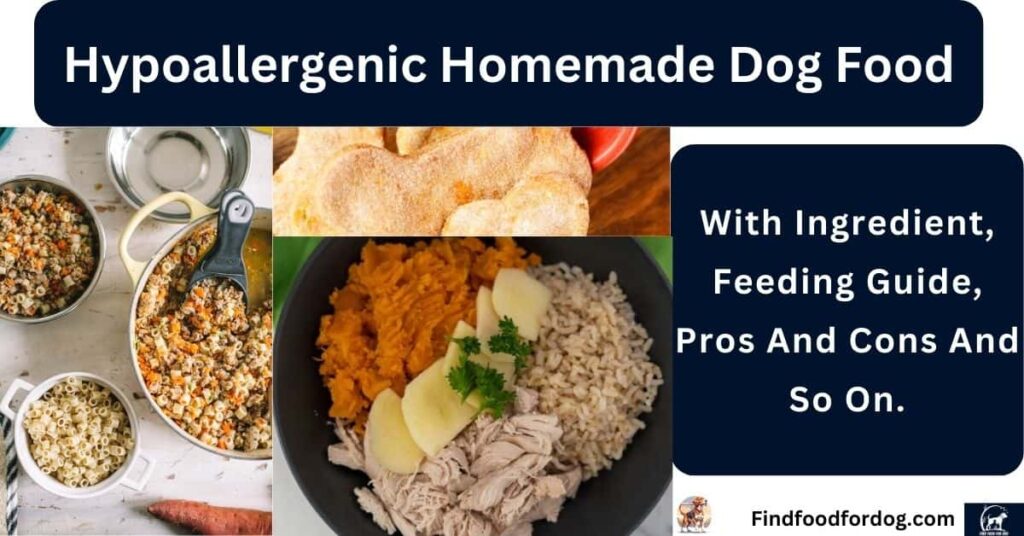Hypoallergenic dog food recipes often include limited ingredients to reduce allergens. Common components are single protein sources and easily digestible carbohydrates.
Pet owners increasingly seek hypoallergenic dog food to address allergies and sensitivities. Many dogs experience reactions to common ingredients, leading to discomfort and health issues. Creating a hypoallergenic dog food recipe at home can help ensure your pet gets safe, nutritious meals tailored to their needs.
By focusing on high-quality, natural ingredients, you can minimize the risk of allergic reactions. This approach allows you to monitor what your dog consumes and make adjustments as necessary. With the right ingredients, you can provide a diet that supports your dog’s health and well-being, keeping them happy and vibrant.

The Rise Of Canine Allergies
Canine allergies have become more common in recent years. Many dogs suffer from food allergies. These allergies can cause discomfort and health issues. Owners need to be aware of the signs. Understanding triggers helps in managing these allergies effectively.
Common Triggers In Dog Food
Identifying common triggers is essential for your dog's health. Here are some typical allergens found in dog food:
- Beef: A prevalent protein source that can cause reactions.
- Dairy: Many dogs are lactose intolerant.
- Wheat: A common grain that can lead to allergies.
- Chicken: Another frequent protein that may trigger allergies.
- Fish: Can also be an allergen for some dogs.
Reading labels helps avoid these common allergens. Look for hypoallergenic dog food options.
Symptoms To Watch For
Recognizing symptoms of allergies is crucial. Here are signs your dog may have a food allergy:
- Itchy skin or paws
- Red or inflamed skin
- Ear infections
- Vomiting or diarrhea
- Excessive licking or scratching
Monitor your dog closely. Consult a vet if symptoms persist. Early intervention leads to better outcomes.
Understanding Hypoallergenic Dog Food
Hypoallergenic dog food is designed for pups with food allergies. This type of food helps reduce allergic reactions. Many dogs suffer from skin issues or digestive problems due to certain ingredients. Choosing the right food can improve their health and happiness.
Defining Hypoallergenic Options
Hypoallergenic options are made with specific ingredients. They typically avoid common allergens. Here are some key features:
- Limited Ingredients: Fewer ingredients reduce allergy triggers.
- Novel Proteins: Ingredients like duck or venison are less common.
- Grain-Free: Many dogs are sensitive to grains.
- Hydrolyzed Proteins: Proteins are broken down to avoid reactions.
Always check labels for hypoallergenic guarantees. Consult your vet before changing your dog's diet.
Benefits For Sensitive Pups
Hypoallergenic dog food offers many benefits for sensitive pups. Here are some major advantages:
- Reduced Allergies: Less itching and discomfort for dogs.
- Improved Digestion: Easier to digest for sensitive stomachs.
- Healthier Skin: Fewer rashes and irritation.
- Better Energy Levels: Dogs feel more energetic and happy.
Choosing hypoallergenic food can lead to a healthier life for your dog. Monitor your pup’s reactions after switching foods.
Key Ingredients For Allergy-friendly Meals
Creating hypoallergenic dog food requires careful selection of ingredients. The right components help avoid allergens. Focus on quality proteins, healthy carbohydrates, and essential fatty acids.
Selecting The Right Protein
Protein is vital for your dog's health. Choose proteins that are less likely to cause allergies. Here are some great options:
- Turkey – A lean meat, easy to digest.
- Rabbit – Novel protein, great for sensitive dogs.
- Fish – Omega-3 rich, promotes healthy skin.
- Quail – Low in allergens, high in nutrients.
Always introduce new proteins slowly. Monitor your dog for any reactions.
Carbs That Care
Carbohydrates provide energy. Choose hypoallergenic sources. Some safe options include:
| Carbohydrate Source | Benefits |
|---|---|
| Sweet Potatoes | Rich in fiber and vitamins. |
| Brown Rice | Easy to digest and gluten-free. |
| Quinoa | Complete protein and gluten-free. |
Avoid grains like wheat and corn. They often trigger allergies.
Essential Fatty Acids For Health
Essential fatty acids support skin and coat health. They also reduce inflammation. Include these sources:
- Fish Oil – High in Omega-3 fatty acids.
- Flaxseed Oil – Good for skin and coat.
- Chicken Fat – Provides energy and flavor.
These oils promote overall well-being. They help your dog feel their best.

Diy Hypoallergenic Dog Food
Making your own hypoallergenic dog food can be rewarding. It allows you to control ingredients and avoid allergens. This ensures your dog stays healthy and happy.
Home Cooking Vs. Store Bought
Choosing between homemade and store-bought hypoallergenic food is important. Here are the pros and cons of each:
| Option | Pros | Cons |
|---|---|---|
| Home Cooking |
|
|
| Store Bought |
|
|
Tools And Tips For Getting Started
Gather the right tools to make cooking easier:
- Sharp knife
- Cutting board
- Measuring cups
- Mixing bowls
- Food processor (optional)
Follow these tips for a successful cooking experience:
- Choose high-quality ingredients.
- Consult with a vet before making changes.
- Start with simple recipes.
- Gradually introduce new foods to your dog.
- Store leftovers properly to maintain freshness.
Try to keep your dog's diet consistent. Regular meals help their digestion.
Simple Hypoallergenic Dog Food Recipe
Creating a simple hypoallergenic dog food recipe is easy. This recipe helps dogs with allergies. It uses basic ingredients that are gentle on their stomachs. Your furry friend will love the taste. Let’s dive into the recipe details!
Step-by-step Cooking Guide
- Ingredients:
- 2 cups of brown rice
- 1 pound of ground turkey
- 1 cup of carrots, chopped
- 1 cup of peas, canned or frozen
- ½ cup of pumpkin puree
- Cooking Steps:
- In a large pot, cook the brown rice according to package instructions.
- In a separate pan, cook the ground turkey until no longer pink.
- Add the chopped carrots and peas. Cook for another 5 minutes.
- Mix in the cooked rice and pumpkin puree. Stir well.
- Let the mixture cool before serving it to your dog.
Portion Sizes And Storage
| Dog Size | Portion Size | Storage Method |
|---|---|---|
| Small Dogs (up to 20 lbs) | 1 cup per day | Store in an airtight container in the fridge |
| Medium Dogs (21-50 lbs) | 2 cups per day | Store in an airtight container in the fridge |
| Large Dogs (51 lbs and above) | 3 cups per day | Store in an airtight container in the fridge |
Homemade hypoallergenic dog food is a great choice. Store any leftovers properly to maintain freshness. Your dog deserves the best nutrition!

Integrating Homemade Food Into Your Dog's Diet
Homemade dog food can be a great option for dogs with allergies. It allows you to control the ingredients. This ensures your dog eats healthy and safe meals.
Transitioning Safely
Changing your dog's diet should be done gradually. A sudden change can upset their stomach. Follow these simple steps for a smooth transition:
- Start with a mix: Combine old food with homemade food.
- Increase the homemade portion: Gradually add more homemade food.
- Monitor your dog: Watch for any signs of discomfort.
For the first week, use a 25% homemade mix. Gradually increase it to 50% by the second week. Continue until your dog is fully on homemade food.
Monitoring Your Dog’s Reaction
Keep an eye on how your dog reacts to the new food. Look for any changes in behavior or health. Important signs to watch include:
- Stomach upset: Vomiting or diarrhea.
- Allergic reactions: Itching or swelling.
- Energy levels: Is your dog more energetic?
Keep a journal of your dog's reactions. Note any changes in their mood or health. Consult your vet if you notice anything unusual.
Supplements And Additives For Complete Nutrition
Creating a balanced hypoallergenic dog food recipe requires careful attention to nutrition. Supplements and additives can help ensure your dog gets all essential nutrients. These additions can support overall health and well-being.
Vitamins And Minerals Essentials
Vitamins and minerals play a crucial role in your dog's diet. They help maintain energy levels and support immune function. Here are some key vitamins and minerals to consider:
| Vitamin/Mineral | Benefits | Sources |
|---|---|---|
| Vitamin A | Supports vision and skin health | Carrots, sweet potatoes |
| Vitamin D | Promotes bone health | Fish, egg yolks |
| Calcium | Strengthens bones and teeth | Leafy greens, dairy |
| Omega-3 Fatty Acids | Supports skin and coat health | Fish oil, flaxseed |
Incorporating these vitamins and minerals ensures your dog's diet remains balanced.
When To Consider Supplements
Some dogs may need extra support through supplements. Consider these situations:
- Dogs with food allergies or sensitivities
- Dogs recovering from illness or surgery
- Senior dogs with changing nutritional needs
Consult a veterinarian before adding any supplements. They can recommend the right options based on your dog's specific needs.
Always monitor your dog's response to any new supplements. Adjustments may be necessary to achieve optimal health.
Consulting With A Vet Before Switching Diets
Changing your dog's diet can impact their health. Always consult a vet first. They can help determine if your dog needs a hypoallergenic diet. A vet understands your dog's unique needs. They can recommend the right food and monitor any changes.
The Role Of Food Trials
Food trials are essential for identifying allergies. These trials help find the right diet for your dog. Here's how they work:
- Choose a limited ingredient diet.
- Feed this diet for 8-12 weeks.
- Monitor your dog for any allergic reactions.
Food trials help narrow down the allergens. They provide a clear path to a suitable diet.
Interpreting Allergy Tests
Allergy tests can guide your dog's diet. Tests can identify specific food allergies. These tests include:
- Skin tests
- Blood tests
Consult your vet about the best test for your dog. Results can help in choosing hypoallergenic foods. Understanding these results is crucial for your dog's health.
| Test Type | Description | Purpose |
|---|---|---|
| Skin Test | Tests reactions to allergens on the skin. | Identifies environmental and food allergies. |
| Blood Test | Measures antibodies to specific allergens. | Helps pinpoint food allergies. |
Proper interpretation of these tests leads to better dietary choices. A vet's guidance is key in this process.
Success Stories And Testimonials
Many dog owners have found success with hypoallergenic dog food recipes. These recipes have transformed their pets' health. Here are some real stories from satisfied owners.
Owners Share Their Experiences
Pet owners report great changes after switching to hypoallergenic diets. Here are some testimonials:
- Sarah M.: “My dog, Max, had skin issues. After switching, his coat is shiny!”
- John D.: “Bella had digestive problems. Now she eats without any issues!”
- Lisa T.: “Rocky’s allergies disappeared. He is so much happier now!”
Improvements Observed
Many owners notice significant improvements in their dogs. Here are common benefits:
| Improvement | Percentage of Owners |
|---|---|
| Healthier Skin | 75% |
| Better Digestion | 80% |
| Increased Energy | 70% |
| Reduced Allergies | 85% |
These testimonials show the positive impact of hypoallergenic dog food recipes. Many pets thrive on these diets. Owners feel happier seeing their pets healthy and active.
Navigating The Future Of Dog Nutrition
Dog nutrition is evolving rapidly. Owners seek better options for their pets. Hypoallergenic dog food is a key focus. This food helps dogs with allergies thrive. New innovations and research drive this change.
Innovations In Hypoallergenic Food
Innovative ingredients are transforming hypoallergenic dog food. Here are some notable advancements:
- Novel Proteins: Ingredients like duck, kangaroo, and salmon.
- Limited Ingredient Diets: Fewer components reduce allergy risks.
- Functional Additives: Probiotics and omega fatty acids enhance health.
These innovations improve digestion and overall health. Pet owners can choose tailored diets for their dogs. This ensures better quality of life.
The Role Of Ongoing Research
Research plays a vital role in hypoallergenic dog food. Scientists study allergies and food sensitivities. Their findings guide new product development.
| Research Focus | Benefits |
|---|---|
| Ingredient sourcing | Identifies safe, hypoallergenic options. |
| Digestive health | Improves nutrient absorption and gut health. |
| Allergy triggers | Minimizes common allergens in dog food. |
Ongoing research helps create better products. Owners benefit from informed choices. Dogs enjoy healthier, happier lives.
Frequently Asked Questions About Hypoallergenic Dog Food Recipe
What Is Hypoallergenic Dog Food?
Hypoallergenic dog food is specially formulated to minimize allergic reactions in dogs. It often contains limited ingredients and avoids common allergens like wheat, soy, and dairy. This type of food can help dogs with food sensitivities digest better and improve their overall health and well-being.
How To Make Homemade Hypoallergenic Dog Food?
To make homemade hypoallergenic dog food, use ingredients like lean meats, sweet potatoes, and carrots. Cook these ingredients thoroughly and mix them well. Ensure the recipe avoids common allergens. Consult your vet for specific ingredient recommendations tailored to your dog's needs.
What Ingredients Are Safe For Dogs With Allergies?
Safe ingredients for dogs with allergies typically include novel proteins like lamb or duck and carbohydrate sources like brown rice or sweet potatoes. Avoid common allergens such as chicken, corn, and soy. Always check with a veterinarian before introducing new ingredients to your dog's diet.
Can Hypoallergenic Food Help Skin Issues?
Yes, hypoallergenic food can help alleviate skin issues related to allergies. By eliminating common allergens, it may reduce itching, redness, and inflammation. However, results can vary among dogs. Always consult your vet for a tailored approach to your dog’s skin health.
Conclusion
Creating a hypoallergenic dog food recipe can greatly improve your pet's health and happiness. Tailoring meals to suit their needs helps prevent allergies and supports overall well-being. Remember to consult your vet before making any changes. Your furry friend deserves the best nutrition for a long, vibrant life.














